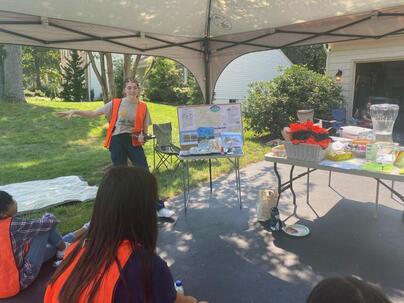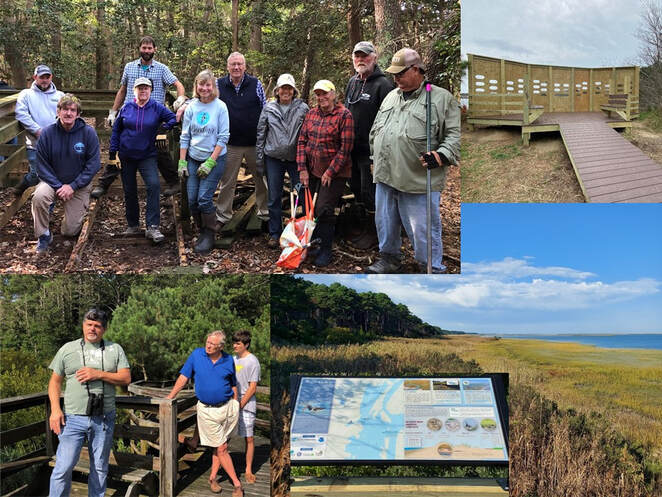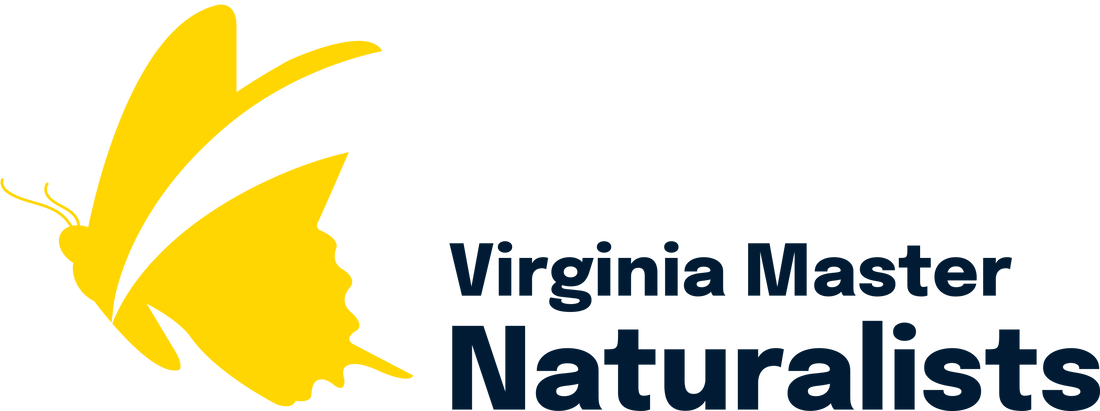Each quarter, we invite VMN chapters to share stories of volunteers' awards and accomplishments. Our Laurels posts are not only a way to provide recognition to those volunteers, but also an opportunity to inspire other volunteers. If you are inspired by one of the projects or accomplishments mentioned here and want more information, please contact the VMN state office and we'll put you in touch!
 Mackenzie Nordai earned her Girl Scout Gold Award by educating her community about nonpoint source pollution. Photo courtesy of Mackenzie Nordai, VMN Fairfax Chapter.
Mackenzie Nordai earned her Girl Scout Gold Award by educating her community about nonpoint source pollution. Photo courtesy of Mackenzie Nordai, VMN Fairfax Chapter. Fairfax VMN Volunteer Earns Gold Award
Mackenzie Nordai of the Fairfax Chapter recently earned her Girl Scout Gold Award by educating the public on nonpoint source pollution and labeling stormwater drains. She is a Spring 2020 VMN graduate who attended the basic training course with her mother Karen.
The Girl Scout Gold Award is the highest award a Girl Scout Senior or Ambassador can earn. A Gold Award Take Action Project has national and/or global links, is sustainable, takes approximately 80 hours and addresses an issue the Girl Scout cares about. For Mackenzie's project, she organized volunteers in three communities to label storm drains in the Pohick Creek watershed to raise awareness of where the drains lead. She also educated community members about the watershed and nonpoint source pollution through communication channels such as neighborhood newsletters, bulletin boards, and social media.
Read more about Mackenzie's project in an article she wrote for the Fairfax Chapter website!
Mackenzie Nordai of the Fairfax Chapter recently earned her Girl Scout Gold Award by educating the public on nonpoint source pollution and labeling stormwater drains. She is a Spring 2020 VMN graduate who attended the basic training course with her mother Karen.
The Girl Scout Gold Award is the highest award a Girl Scout Senior or Ambassador can earn. A Gold Award Take Action Project has national and/or global links, is sustainable, takes approximately 80 hours and addresses an issue the Girl Scout cares about. For Mackenzie's project, she organized volunteers in three communities to label storm drains in the Pohick Creek watershed to raise awareness of where the drains lead. She also educated community members about the watershed and nonpoint source pollution through communication channels such as neighborhood newsletters, bulletin boards, and social media.
Read more about Mackenzie's project in an article she wrote for the Fairfax Chapter website!
Eastern Shore Master Naturalists Make A New Site Great for Both Birds and People
By Shannon Alexander, VDCR Natural Heritage Program Coastal Region Steward and Eastern Shore Master Naturalists Chapter Advisor
In 2019, the Eastern Shore Chapter of the Virginia Master Naturalists began an exciting collaborative project between the Eastern Shore of Virginia Birding and Wildlife Programs (AKA Birding Eastern Shore), Virginia Master Naturalists, and Northampton County government. This teamwork has led to an approximately 100-acre site, which is now providing important habitat for migratory songbirds, waterfowl, and other wildlife with field, forest, fresh water pond, and salt-water marsh. It is now a beautiful location for residents and visitors to enjoy and for educators to bring students.
Following the sudden passing of local, well-known birder Ned Brinkley, the County renamed the Preserve in his honor. The County is in the process of constructing a new parking area and is responsible for mowing and maintenance of the property. Master Naturalists continue to provide hours to improve, monitor, and maintain the seaside boardwalk (constructed with support from the NOAA Virginia Coastal Zone Management Program), waterfowl viewing platforms, and the Preserve as a whole. There is even an official VMN Volunteer Stewardship Committee, whose members complete weekly stewardship walks of the Preserve and create a report accordingly.
The public has enthusiastically received the site. In large part due to the development of the viewing platforms, the site has had the sixth largest number of species sighted in the county, with 172 bird species identified so far at the location. Additionally, VMN report a diversity of lepidopteran, ordonates, and amphibians. With natural assets being greatly important to the culture and economy of the County, this Preserve is a win win for wildlife, residents, and visitors. Working with multiple partners to establish new preserves can be challenging, but the benefits worth the effort. Without the time and determination of several passionate members of the Eastern Shore Chapter, this preserve would not be transforming into a treasured area in the County.
More information available online on the Northampton County site, the DWR Virginia Bird & Wildlife Trail site, and the Birding Eastern Shore site.
By Shannon Alexander, VDCR Natural Heritage Program Coastal Region Steward and Eastern Shore Master Naturalists Chapter Advisor
In 2019, the Eastern Shore Chapter of the Virginia Master Naturalists began an exciting collaborative project between the Eastern Shore of Virginia Birding and Wildlife Programs (AKA Birding Eastern Shore), Virginia Master Naturalists, and Northampton County government. This teamwork has led to an approximately 100-acre site, which is now providing important habitat for migratory songbirds, waterfowl, and other wildlife with field, forest, fresh water pond, and salt-water marsh. It is now a beautiful location for residents and visitors to enjoy and for educators to bring students.
Following the sudden passing of local, well-known birder Ned Brinkley, the County renamed the Preserve in his honor. The County is in the process of constructing a new parking area and is responsible for mowing and maintenance of the property. Master Naturalists continue to provide hours to improve, monitor, and maintain the seaside boardwalk (constructed with support from the NOAA Virginia Coastal Zone Management Program), waterfowl viewing platforms, and the Preserve as a whole. There is even an official VMN Volunteer Stewardship Committee, whose members complete weekly stewardship walks of the Preserve and create a report accordingly.
The public has enthusiastically received the site. In large part due to the development of the viewing platforms, the site has had the sixth largest number of species sighted in the county, with 172 bird species identified so far at the location. Additionally, VMN report a diversity of lepidopteran, ordonates, and amphibians. With natural assets being greatly important to the culture and economy of the County, this Preserve is a win win for wildlife, residents, and visitors. Working with multiple partners to establish new preserves can be challenging, but the benefits worth the effort. Without the time and determination of several passionate members of the Eastern Shore Chapter, this preserve would not be transforming into a treasured area in the County.
More information available online on the Northampton County site, the DWR Virginia Bird & Wildlife Trail site, and the Birding Eastern Shore site.

Walkway Construction Photo Credit: Stefanie Jackson and Martina Coker. From top left to bottom left, clockwise: VMN and Northampton County staff - Jeff Doughty, Richard Ayers, Judy Illmensee, James Vernon Simpson, Martina Coker, John Coker, Barbara O’Hare, Sandra Shultz, Steve Grimes, and Hal Pfingst; First pond birding blind; view from the Seaside Walkway overlook; Interpretive sign; Dr. Edward S. Brinkley speaking to Northampton County Supervisor and VMN John Coker and his grandson Maarten Rosse. Compiled by Shannon Alexander, VDCR Natural Heritage and Eastern Shore Master Naturalist Chapter Advisor.
 Monarch butterfly. Photo by VMN Old Rag Chapter.
Monarch butterfly. Photo by VMN Old Rag Chapter. Old Rag Master Naturalist Volunteers Monitor Monarchs
Contributed by Barry Buschow, Charlene Uhl, Jeff Stehm, and Bonnie Beers, VMN-Old Rag Chapter.
The Old Rag Master Naturalist chapter approved the Monarch Larva Monitoring Project (MLMP) in 2016. From April to September, our volunteers monitor monarch butterfly eggs and larvae in three different locations on a 130-acre farm owned by ORMN member Carolyn Smith. The farm has several meadows where milkweed grows naturally, as well as two areas where milkweed was planted. Monitoring activities include describing the size, quality, and characteristics of site; recording the date when milkweed first appears in the spring, describing milkweed density, examining each milkweed plant in registered plots, and recording monarch eggs and larval instars observed. All of this information is sent to the University of Wisconsin for its research into monarch conservation.
Like that of many insects, the survival rate of monarchs in the wild is very low. After the monitoring team observed over 100 monarch eggs on milkweed plants in early May, they were dismayed that only one of that batch survived to adulthood. Virginia sees many more monarchs migrating southward in the fall than northward in the spring, and our August-September survival numbers were higher. At its busiest, our “monarch nursery” had nearly 50 chrysalids hanging on a line outdoors while late-stage caterpillars munched on milkweed in enclosures that kept them safe from predators and parasitoids. Watching caterpillars pupate and, 10-14 days later, eclose as butterflies was the highlight of raising them. Seeing them take their maiden flight into the wild was the final thrill as we wished them bon voyage to Mexico!
This year the ORMN Monarch team invited chapter members to participate in a field trip to Carolyn’s farm. Two sites were open for observation: a wild site with established common milkweed plants that is mowed only once a year; and a cultivated garden patch that has five native milkweed species as well as a wide variety of nectar plants for monarchs. Twelve ORMN members had the opportunity to examine milkweed up close (often using a magnifying lens) for eggs and caterpillars and learned how data are compiled for a national database that has been active since 1997. The monarch nursery was also open. Here field trip participants were able to view monarch caterpillars and chrysalids as well as videos of a caterpillar pupating and a butterfly eclosing.
This hands-on experience and the lively interaction between the Monarch monitoring team and participating ORMN members was enjoyed by all – and it developed a greater appreciation for the important role that data about Monarchs and their migratory experience offers scientists around the world.
Contributed by Barry Buschow, Charlene Uhl, Jeff Stehm, and Bonnie Beers, VMN-Old Rag Chapter.
The Old Rag Master Naturalist chapter approved the Monarch Larva Monitoring Project (MLMP) in 2016. From April to September, our volunteers monitor monarch butterfly eggs and larvae in three different locations on a 130-acre farm owned by ORMN member Carolyn Smith. The farm has several meadows where milkweed grows naturally, as well as two areas where milkweed was planted. Monitoring activities include describing the size, quality, and characteristics of site; recording the date when milkweed first appears in the spring, describing milkweed density, examining each milkweed plant in registered plots, and recording monarch eggs and larval instars observed. All of this information is sent to the University of Wisconsin for its research into monarch conservation.
Like that of many insects, the survival rate of monarchs in the wild is very low. After the monitoring team observed over 100 monarch eggs on milkweed plants in early May, they were dismayed that only one of that batch survived to adulthood. Virginia sees many more monarchs migrating southward in the fall than northward in the spring, and our August-September survival numbers were higher. At its busiest, our “monarch nursery” had nearly 50 chrysalids hanging on a line outdoors while late-stage caterpillars munched on milkweed in enclosures that kept them safe from predators and parasitoids. Watching caterpillars pupate and, 10-14 days later, eclose as butterflies was the highlight of raising them. Seeing them take their maiden flight into the wild was the final thrill as we wished them bon voyage to Mexico!
This year the ORMN Monarch team invited chapter members to participate in a field trip to Carolyn’s farm. Two sites were open for observation: a wild site with established common milkweed plants that is mowed only once a year; and a cultivated garden patch that has five native milkweed species as well as a wide variety of nectar plants for monarchs. Twelve ORMN members had the opportunity to examine milkweed up close (often using a magnifying lens) for eggs and caterpillars and learned how data are compiled for a national database that has been active since 1997. The monarch nursery was also open. Here field trip participants were able to view monarch caterpillars and chrysalids as well as videos of a caterpillar pupating and a butterfly eclosing.
This hands-on experience and the lively interaction between the Monarch monitoring team and participating ORMN members was enjoyed by all – and it developed a greater appreciation for the important role that data about Monarchs and their migratory experience offers scientists around the world.
 Carolyn Smith planting trees on her farm. Photo courtesty of VMN Old Rag Chapter.
Carolyn Smith planting trees on her farm. Photo courtesty of VMN Old Rag Chapter. Carolyn Smith Receives Wildlife Habitat Award
Contributed by Barry Buschow, Charlene Uhl, Jeff Stehm, and Bonnie Beers, VMN-Old Rag Chapter.
Culpeper Soil and Water Conservation District (CSWCD), which includes Culpeper, Greene, Madison, Orange and Rappahannock Counties, annually recognizes landowners and volunteers for outstanding contributions to natural resources. In addition to recognizing producers in each County with the Commonwealth’s Clean Water Farm Award, the District offers several local awards. These include Conservation Educator, Forestry Landowner and Wildlife Habitat. The Wildlife Habitat Award was added in 2012 to recognize landowners that didn’t always fit into the Clean Water Farm Award category.
For 2021, CSWCD received two nominations. The CSWCD Board of Directors chose ORMN member Carolyn Smith of Madison to receive this special recognition. According to NRCS Soil Conservationist Courtney Pooton Kidwell, who nominated Smith: “Carolyn wants to improve sustainability through wildlife habitat improvement. She works to increase viable habitat with diverse native plant communities. She wants to maintain and improve the native forest quality through removal of invasive species, forest soil quality improvements to reduce erosion and compaction, and increase forest continuity through field borders and other tree and shrub plantings.”
In the near future, Culpeper SWCD plans to officially recognize Carolyn with a plaque in an on-farm presentation.
Contributed by Barry Buschow, Charlene Uhl, Jeff Stehm, and Bonnie Beers, VMN-Old Rag Chapter.
Culpeper Soil and Water Conservation District (CSWCD), which includes Culpeper, Greene, Madison, Orange and Rappahannock Counties, annually recognizes landowners and volunteers for outstanding contributions to natural resources. In addition to recognizing producers in each County with the Commonwealth’s Clean Water Farm Award, the District offers several local awards. These include Conservation Educator, Forestry Landowner and Wildlife Habitat. The Wildlife Habitat Award was added in 2012 to recognize landowners that didn’t always fit into the Clean Water Farm Award category.
For 2021, CSWCD received two nominations. The CSWCD Board of Directors chose ORMN member Carolyn Smith of Madison to receive this special recognition. According to NRCS Soil Conservationist Courtney Pooton Kidwell, who nominated Smith: “Carolyn wants to improve sustainability through wildlife habitat improvement. She works to increase viable habitat with diverse native plant communities. She wants to maintain and improve the native forest quality through removal of invasive species, forest soil quality improvements to reduce erosion and compaction, and increase forest continuity through field borders and other tree and shrub plantings.”
In the near future, Culpeper SWCD plans to officially recognize Carolyn with a plaque in an on-farm presentation.


 RSS Feed
RSS Feed